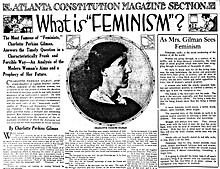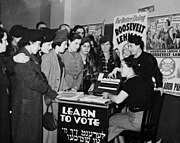Unions and strikes[edit]
Skilled workers banded together to control their crafts and raise wages by forming labor unions in industrial areas of the Northeast. Before the 1930s few factory workers joined the unions in the labor movement. Samuel Gompers led the American Federation of Labor (1886–1924), coordinating multiple unions. Industrial growth was rapid, led by John D. Rockefeller in oil and Andrew Carnegie in steel; both became leaders of philanthropy (Gospel of Wealth), giving away their fortunes to create the modern system of hospitals, universities, libraries, and foundations.
The Panic of 1893 broke out and was a severe nationwide depression impacting farmers, workers, and businessmen who saw prices, wages, and profits fall.[131] Many railroads went bankrupt. The resultant political reaction fell on the Democratic Party, whose leader President Grover Cleveland shouldered much of the blame. Labor unrest involved numerous strikes, most notably the violent Pullman Strike of 1894, which was shut down by federal troops under Cleveland's orders. The Populist Party gained strength among cotton and wheat farmers, as well as coal miners, but was overtaken by the even more popular Free Silver movement, which demanded using silver to enlarge the money supply, leading to inflation that the silverites promised would end the depression.[132]
The financial, railroad, and business communities fought back hard, arguing that only the gold standard would save the economy. In the most intense election in the nation's history, conservative Republican William McKinley defeated silverite William Jennings Bryan, who ran on the Democratic, Populist, and Silver Republican tickets. Bryan swept the South and West, but McKinley ran up landslides among the middle class, industrial workers, cities, and among upscale farmers in the Midwest.[133]
Prosperity returned under McKinley, the gold standard was enacted, and the tariff was raised. By 1900 the U.S. had the strongest economy on the globe. Apart from two short recessions (in 1907 and 1920) the overall economy remained prosperous and growing until 1929. Republicans, citing McKinley's policies, took the credit.[134]
Imperialism[edit]
The United States emerged as a world economic and military power after 1890. The main episode was the Spanish–American War, which began when Spain refused American demands to reform its oppressive policies in Cuba.[136] The "splendid little war", as one official called it, involved a series of quick American victories on land and at sea. At the Treaty of Paris peace conference the United States acquired the Philippines, Puerto Rico, and Guam.[137]
Cuba became an independent country, under close American tutelage. Although the war itself was widely popular, the peace terms proved controversial. William Jennings Bryan led his Democratic Party in opposition to control of the Philippines, which he denounced as imperialism unbecoming to American democracy.[137] President William McKinley defended the acquisition and was riding high as the nation had returned to prosperity and felt triumphant in the war. McKinley easily defeated Bryan in a rematch in the 1900 presidential election.[138]
After defeating an insurrection by Filipino nationalists, the United States achieved little in the Philippines except in education, and it did something in the way of public health. It also built roads, bridges, and wells, but infrastructural development lost much of its early vigor with the failure of the railroads.[139] By 1908, however, Americans lost interest in an empire and turned their international attention to the Caribbean, especially the building of the Panama Canal. The canal opened in 1914 and increased trade with Japan and the rest of the Far East. A key innovation was the Open Door Policy, whereby the imperial powers were given equal access to Chinese business, with not one of them allowed to take control of China.[140]
Discontent and reform[edit]
Progressive Era[edit]
Dissatisfaction on the part of the growing middle class with the corruption and inefficiency of politics as usual, and the failure to deal with increasingly important urban and industrial problems, led to the dynamic Progressive Movement starting in the 1890s. In every major city and state, and at the national level as well, and in education, medicine, and industry, the progressives called for the modernization and reform of decrepit institutions, the elimination of corruption in politics, and the introduction of efficiency as a criterion for change. Leading politicians from both parties, most notably Theodore Roosevelt, Charles Evans Hughes, and Robert La Follette on the Republican side, and William Jennings Bryan and Woodrow Wilson on the Democratic side, took up the cause of progressive reform. Women became especially involved in demands for woman suffrage, prohibition, and better schools; their most prominent leader was Jane Addams of Chicago, who created settlement houses. "Muckraking" journalists such as Upton Sinclair, Lincoln Steffens and Jacob Riis exposed corruption in business and government along with rampant inner-city poverty. Progressives implemented antitrust laws and regulated such industries of meat-packing, drugs, and railroads. Four new constitutional amendments – the Sixteenth through Nineteenth – resulted from progressive activism, bringing the federal income tax, direct election of Senators, prohibition, and woman suffrage.[141] The period also saw a major transformation of the banking system with the creation of the Federal Reserve System in 1913[142] and the arrival of cooperative banking in the US with the founding of the first credit union in 1908.[143] The Progressive Movement lasted through the 1920s; the most active period was 1900–18.[144]
Women's suffrage[edit]
The women's suffrage movement began with the June 1848 National Convention of the Liberty Party. Presidential candidate Gerrit Smith argued for and established women's suffrage as a party plank. One month later, his cousin Elizabeth Cady Stanton joined with Lucretia Mott and other women to organize the Seneca Falls Convention, featuring the Declaration of Sentiments demanding equal rights for women, and the right to vote.[145] Many of these activists became politically aware during the abolitionist movement. The women's rights campaign during "first-wave feminism" was led by Stanton, Lucy Stone and Susan B. Anthony, among many others. Stone and Paulina Wright Davis organized the prominent and influential National Women's Rights Convention in 1850. The movement reorganized after the Civil War, gaining experienced campaigners, many of whom had worked for prohibition in the Women's Christian Temperance Union. By the end of the 19th century a few western states had granted women full voting rights,[146] though women had made significant legal victories, gaining rights in areas such as property and child custody.[147]
Around 1912 the feminist movement began to reawaken, putting an emphasis on its demands for equality and arguing that the corruption of American politics demanded purification by women because men could not do that job.[148] Protests became increasingly common as suffragette Alice Paul led parades through the capital and major cities. Paul split from the large National American Woman Suffrage Association (NAWSA), which favored a more moderate approach and supported the Democratic Party and Woodrow Wilson, led by Carrie Chapman Catt, and formed the more militant National Woman's Party. Suffragists were arrested during their "Silent Sentinels" pickets at the White House, the first time such a tactic was used, and were taken as political prisoners.[149]
The old anti-suffragist argument that only men could fight a war, and therefore only men deserve the right to vote, was refuted by the enthusiastic participation of tens of thousands of American women on the home front in World War I. Across the world, grateful nations gave women the right to vote. Furthermore, most of the Western states had already given the women the right to vote in state and national elections, and the representatives from those states, including the first woman Jeannette Rankin of Montana, demonstrated that woman suffrage was a success. The main resistance came from the south, where white leaders were worried about the threat of black women voting. Congress passed the Nineteenth Amendment in 1919, and women could vote in 1920.[150]
NAWSA became the League of Women Voters, and the National Woman's Party began lobbying for full equality and the Equal Rights Amendment, which would pass Congress during the second wave of the women's movement in 1972. Politicians responded to the new electorate by emphasizing issues of special interest to women, especially prohibition, child health, and world peace.[151][152] The main surge of women voting came in 1928, when the big-city machines realized they needed the support of women to elect Al Smith, a Catholic from New York City. Meanwhile, Protestants mobilized women to support Prohibition and vote for Republican Herbert Hoover.[153]







No comments:
Post a Comment